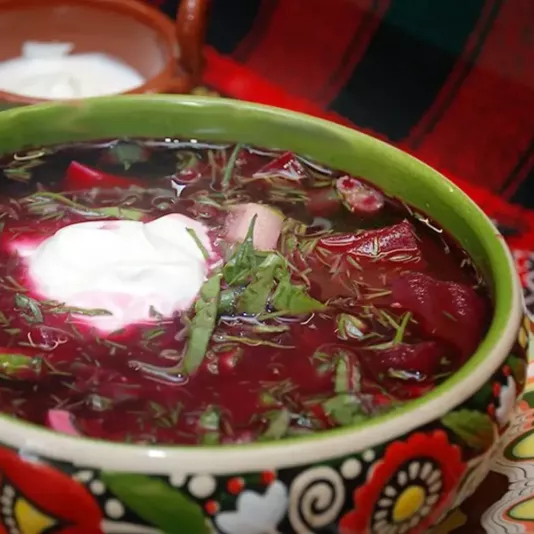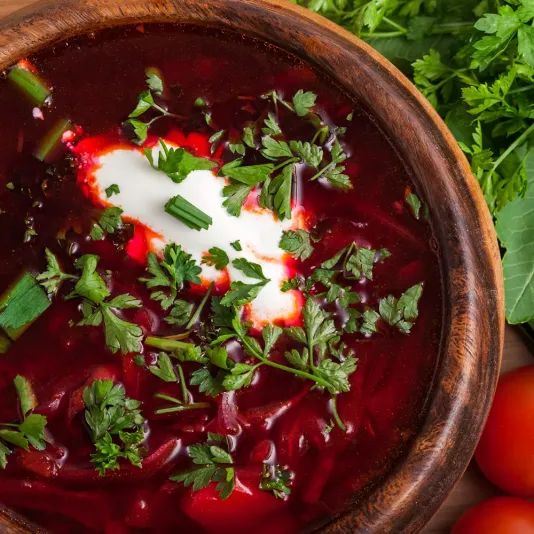Borscht
Recipes of Ukrainian Borscht
In every region, borscht has its own character, and that’s what makes it so unique. I’ve learned to cook it in several styles, but the classic one always remains my favorite. The base is quality broth: I use beef or pork on the bone, simmering for at least two hours on low heat, always skimming the foam to get a clear broth. I add salt only at the end because the liquid evaporates during cooking and the flavor may become too concentrated. After that, I add potatoes, then cabbage, allowing it to soften but not overcook. Separately, I prepare the sauté: I fry the onions until golden, add carrots, then grated beets, a spoonful of tomato paste, and a bit of vinegar or lemon juice. This helps preserve the color and create the signature tanginess. When the vegetables are soft, I add a bit of broth to make the sauce thick, and only then combine everything in the pot. The main thing is not to boil too long after adding the beets, or the color will fade. From experience, I know that borscht needs time to “rest”. An hour after cooking, it becomes thicker, and the flavor deepens. In my family, borscht is always served with sour cream, minced garlic, and herbs. It’s not just a dish but a result of patience and respect for each ingredient.
Traditions of Cooking Borscht
For Ukrainians, borscht is more than food – it’s a ritual, a symbol of abundance and home comfort. I remember how my grandmother cooked borscht in a large clay pot on the stove, and the aroma filled the whole house. She always said, “Don’t rush, daughter, borscht loves calm”. Indeed, when you cook it without fuss, the vegetables release their aroma fully, and the broth becomes tender. Over years of practice, I’ve learned to feel the moment when the dish is “ready” – not by the clock but by the smell. In different regions of Ukraine, traditions vary: in Podillia, they add apples to balance the sweetness of beets; in Poltava, beans; in Volyn, dried mushrooms. I’ve tried many variations but always return to the classic: no excess components, just vegetables, meat, and patience. This combination holds harmony that can’t be replaced. I love that borscht is a dish without a strict recipe. It lives differently in every family. But one thing remains constant – the warmth of the hands that prepare it. I’ve learned that when you cook with love, borscht turns out so good that you’ll want another bowl. And even if you slightly change the ingredients, the spirit of true borscht remains the same – sincere and hospitable, like the Ukrainian heart itself.
Secrets of the Perfect Borscht Flavor
The greatest secret of borscht is precision in the details. Over years of cooking, I’ve realized that flavor isn’t defined by the number of spices or the length of simmering but by understanding proportions and timing. If you add beets too early, the color fades; if you oversalt the broth, the dish loses purity. I always taste it at the final stage when the vegetables are combined. To balance it, I add a little sugar if the beets aren’t sweet enough, or a spoon of tomato if it lacks acidity. I slice the cabbage thinly – that’s important because thick pieces don’t soften evenly. I cut the carrot into thin strips rather than grating it finely so it keeps its shape. I fry the beets in oil with a spoon of butter – it keeps the color bright and deepens the aroma. I salt gradually and add bay leaf and garlic only at the end. This gives a gentle aroma without overpowering the main flavor. When the borscht is ready, I always let it rest – half an hour under a lid or even overnight in the fridge. Afterward, the flavor becomes harmonious, and the color rich. Borscht is a dish that teaches mindfulness: if you treat it without haste, it rewards you with a deep, pure taste that never disappoints.
Serving and Storing Borscht
Borscht is a dish that can be served in dozens of ways, but the main thing is to preserve its natural texture and aroma. I never boil it again – it’s enough to warm it gently so the vegetables don’t overcook or lose color. I serve it in clay bowls – they retain heat longer. The essential companions are sour cream, herbs, minced garlic, and a piece of rye bread or a garlic pampushka. If some borscht remains, I pour it into glass jars and refrigerate it. It can keep up to three days while staying fresh. I don’t recommend freezing – vegetables change texture after thawing. For longer storage, it’s better to cook borscht without potatoes or cabbage and add them fresh during reheating. I’ve noticed that borscht tastes best after a day in the fridge: the aroma deepens, the color stabilizes, and the texture thickens. In my family, we always make a big pot because it disappears faster than expected. And every time I serve it, I feel the same pride – here it is, the result of patience, care, and love passed down through generations.
Modern Variations of Ukrainian Borscht
Today, borscht is experiencing a revival: it’s served in fine-dining restaurants, vegetarian cafes, cooked at festivals, and even turned into a gastronomic symbol of the country. I respect all modern interpretations, but for me, the most important thing is to preserve its essence. Sometimes I roast the beets in the oven to give them a caramelized flavor; sometimes I add roasted tomatoes instead of paste – this makes the taste deeper and more natural. In summer, I love a version with kefir, cucumbers, and herbs – cold, refreshing, light. In autumn, I make thick borscht with mushrooms, where every spoonful smells of the forest. Some people add pumpkin for sweetness – and that’s interesting too. But in all variations, I keep the main thing – respect for tradition. Because borscht isn’t just a dish, it’s memory and character. Its strength lies not in innovation but in harmony between old and new. When I cook borscht, it’s important to me that it reminds me of childhood yet remains alive, modern, capable of surprising with new shades. And every time I see my family gather at the table with a pot of borscht in the center, I realize: this is the true culinary tradition – unity, flavor, and warmth carried from the past into the present.



